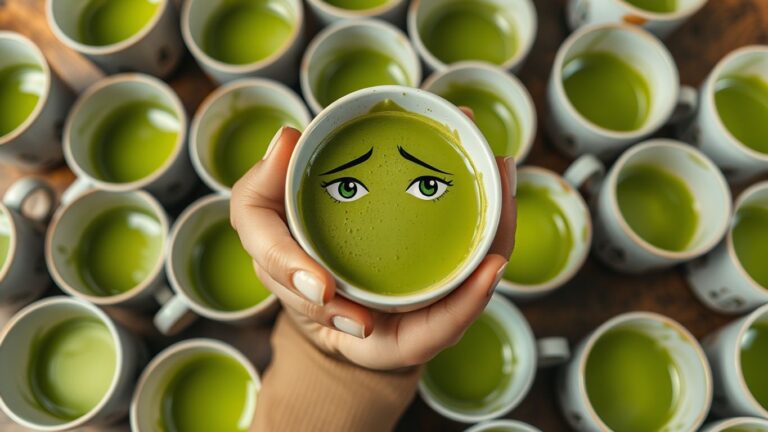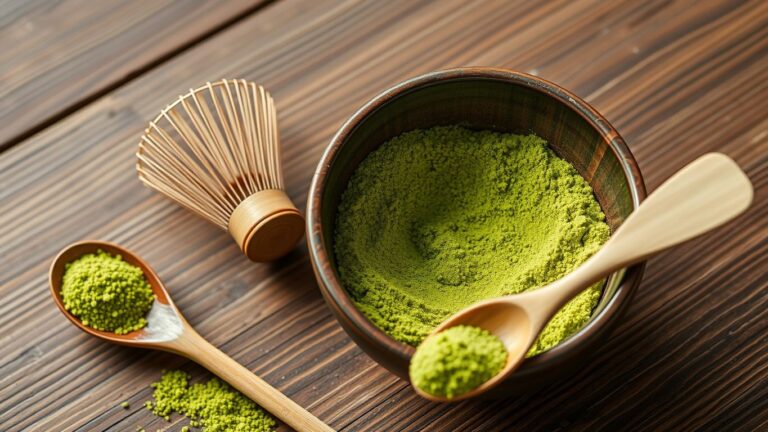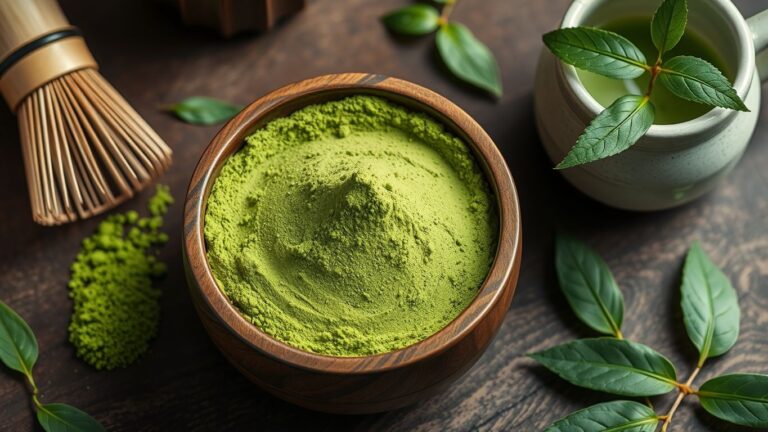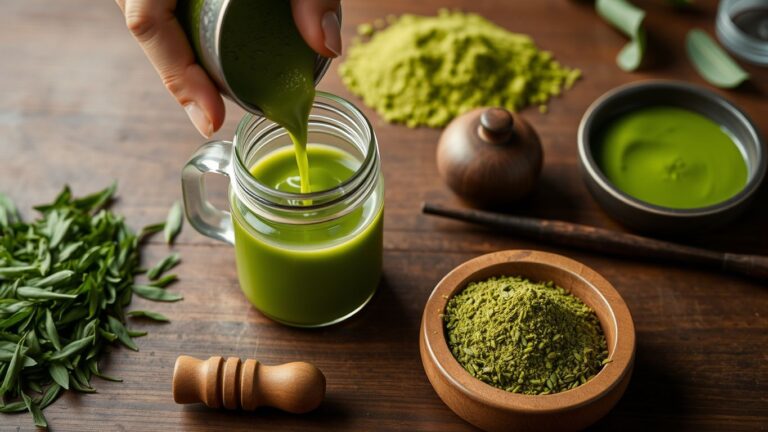Making a perfect cup of matcha can be a delightful ritual, especially when you know how to use a matcha whisk properly. This guide will take you through each step, ensuring you get that smooth, frothy matcha every time. From soaking your whisk to mastering the whisking technique, we’ve got you covered. Let’s dive into the world of matcha and learn how to whisk like a pro!
Key Takeaways
- Soak your bamboo whisk in warm water for about a minute to make it flexible and less likely to break.
- Use a zigzag or ‘M’ and ‘W’ motion when whisking to create a frothy layer on top of your matcha.
- Sift your matcha powder before mixing to prevent clumps and ensure a smooth consistency.
- The ideal water temperature for matcha is between 175°F and 185°F to bring out the best flavor.
- Properly clean and store your matcha whisk to maintain its quality and longevity.
Preparing Your Matcha Whisk
Why Soaking Your Whisk Matters
Before you use your matcha whisk for the first time, it’s important to soak it. Soaking the whisk helps to soften the tines, making them more flexible and less likely to break. This step also helps the whisk bloom, which means the tines will spread out, making it more effective for whisking.
Steps to Soak Your Matcha Whisk
- Fill a bowl with warm water. It doesn’t need to be boiling hot.
- Place the whisk in the water, ensuring that the tines are fully submerged.
- Let it soak for about 5-10 minutes.
- Gently whisk the water back and forth to help the tines soften.
- Remove the whisk and let it air dry for a few minutes before using.
Common Mistakes to Avoid
- Avoid pressing the whisk too hard against the bowl, as this can cause the tines to break.
- Don’t soak the whisk for too long, as this can weaken the bamboo.
- Never use soap or a dishwasher to clean your whisk; simply rinse it with water.
Taking the time to properly prepare your matcha whisk will ensure a smoother, more enjoyable matcha experience.
Gathering Essential Tools and Ingredients

Choosing the Right Matcha Powder
Selecting the right matcha powder is crucial for a delicious cup of matcha. High-quality matcha has a vibrant green color and a smooth, slightly sweet flavor. Avoid low-cost matcha meant for baking, as it can be bitter and less flavorful.
Essential Tools for Whisking Matcha
To make the perfect matcha, you’ll need a few essential tools:
- Chasen (bamboo whisk): This simple and modest tool is very important for several reasons. It helps mix matcha powder, water, and air into a frothy beverage, releasing aromas and essences in the foam on the surface.
- Chawan (matcha bowl): A wide, shallow bowl that allows for proper whisking.
- Chashaku (bamboo scoop): Used to measure the right amount of matcha powder.
- Kettle: For heating water to the ideal temperature.
- Sifter: To ensure a smooth, lump-free matcha.
Optional Accessories to Enhance Your Experience
While not essential, these accessories can enhance your matcha-making experience:
- Matcha whisk stand: Helps maintain the shape of your chasen and prolong its life.
- Thermometer: Ensures your water is at the perfect temperature.
- Matcha storage tin: Keeps your matcha powder fresh and protected from light and moisture.
Investing in the right tools and ingredients can make a significant difference in the quality of your matcha. Enjoy the process and savor each step!
Heating the Water to the Right Temperature
Ideal Water Temperature for Matcha
The key to delicious matcha lies in the water temperature. Using water that’s too hot can make your matcha taste bitter. Aim for a temperature between 175°F and 185°F (80°C to 85°C). This range helps preserve the delicate flavors of the matcha.
How to Heat Water Properly
- Boil the water: Start by boiling water in a kettle.
- Cool it down: Let the water sit for a minute or two to cool down to the ideal temperature.
- Use a thermometer: If you want to be precise, use a kitchen thermometer to check the temperature.
Why Temperature Matters
Water temperature affects the taste and quality of your matcha. Hot water can make it bitter, while water that’s too cool won’t bring out the full flavor. Finding the right balance is essential for a perfect cup of matcha.
Sifting the Matcha Powder
Why Sifting is Important
Sifting your matcha powder is a crucial step in making a smooth and lump-free drink. Skipping this step can lead to clumps that are hard to whisk out, affecting the texture and taste of your matcha. By sifting, you break up any clumps and ensure an even mixture, which makes the whisking process much easier.
How to Sift Matcha Powder
- Gather your tools: You’ll need a fine mesh sifter and a small bowl or plate.
- Measure the matcha: Use a bamboo scoop or teaspoon to measure 1-2 teaspoons of matcha powder.
- Sift the matcha: Place the matcha powder in the sifter and gently tap or stir it through into the bowl. This will break up any clumps and make the powder finer.
Taking the time to sift your matcha powder can make a big difference in the final drink’s quality.
Tools for Sifting Matcha
To get the best results, use a fine mesh sifter specifically designed for matcha. These sifters are made to handle the ultra-fine powder and ensure a smooth, lump-free matcha. If you don’t have a matcha-specific sifter, a regular fine mesh strainer can also work in a pinch.
Creating the Matcha Paste

Mixing Matcha with Cold Water
To start, add a small amount of cold water to your matcha powder. This step is crucial for preventing lumps. Use your chasen to gently whisk it in a slow circular motion until it turns into a thick paste. Avoid creating any bubbles or foam during this process.
Achieving a Lump-Free Paste
A smooth paste is essential for a good matcha experience. Make sure to mix thoroughly, breaking up any clumps. If you see any lumps, keep whisking until they dissolve completely. This will ensure a consistent texture when you add hot water later.
Importance of the Paste Consistency
The consistency of your matcha paste can make or break your final drink. A well-mixed paste should be thick but smooth, without any lumps. This consistency helps in achieving a frothy, well-blended matcha when you add hot water. Remember, the goal is to create a base that will blend seamlessly with the water, enhancing the overall flavor and texture of your matcha.
Whisking Techniques for Perfect Matcha

Whisking matcha is an art that can transform your tea experience. Mastering the right techniques will help you achieve a frothy, aromatic beverage that brings out the full potential of the tea.
Serving Your Whisked Matcha
Once you’ve whisked your matcha to perfection, it’s time to serve it. This step is just as important as the preparation, as it enhances the overall experience of enjoying matcha.
Cleaning and Maintaining Your Matcha Whisk
Taking care of your matcha whisk is essential to ensure it lasts a long time and stays in good condition. Treat it as gently as you can to avoid damaging the delicate tines. Here’s how you can clean and maintain your matcha whisk properly.
Proper Cleaning Techniques
- Rinse Immediately: After whisking, rinse your matcha whisk with warm water. Avoid using soap or putting it in the dishwasher, as this can damage the bamboo.
- Use a Bowl of Water: Instead of rinsing under a faucet, fill a bowl with water and gently whisk the water to remove matcha particles. This method helps prevent mold.
- Gently Rub the Tines: If necessary, you can gently rub the tines with your fingers to remove any remaining matcha. Be careful not to bend or break them.
Drying and Storing Your Whisk
- Pat Dry: Use a paper towel or clean dish towel to gently pat the handle of the whisk dry. Make sure to dry the bottom of the handle as well.
- Air Dry: Place the whisk in a shaded, well-ventilated area to air dry. You can turn it upside down to balance on the base of the handle. Avoid drying it on its side to maintain its shape.
- Avoid Original Container: Do not put the whisk back into its original container, as it may not have enough ventilation and can lead to mold growth.
Common Cleaning Mistakes
- Using Soap: Never use soap to clean your matcha whisk. Water alone is sufficient and gentler on the bamboo.
- Dishwasher: Avoid placing your whisk in the dishwasher, as the high heat and water pressure can damage it.
- Improper Drying: Ensure your whisk is completely dry before storing it. Inadequate drying can cause mold to develop on the bamboo.
Taking good care of your matcha whisk not only shows respect for the tool but also ensures you can enjoy perfectly whisked matcha every time.
Exploring Matcha Whisk Alternatives
Using a Regular Whisk
If you don’t have a bamboo whisk, a regular kitchen whisk can be a decent substitute. However, it won’t aerate the tea as effectively. The metal bristles slice through the water without creating the same frothy texture. With enough effort, you can still make foam, but it will be more challenging. Also, metal can affect the flavor of the matcha, so it’s not the best option.
The Shake Method
Another alternative is the shake method. Simply put your matcha and water in a mason jar or bottle and shake vigorously. This method can create foam, but it often results in clumps. To avoid this, make sure to sift your matcha powder beforehand. This method is convenient but not as effective as using a whisk.
Other Creative Alternatives
- Milk Frother: A milk frother can be a great substitute. It’s battery-operated and spins to aerate the drink. However, it can be just as expensive as a bamboo whisk.
- Blender: Using a blender might seem like a good idea, but it often leaves clumps in the tea. It’s not the most effective method for achieving a smooth texture.
- Fork: In a pinch, you can use a fork to whisk your matcha. It’s not ideal, but it can work if you have no other options.
If you don’t own a bamboo whisk, there are some alternatives. While these methods can work, they won’t give you the same results as a traditional bamboo whisk. The feel and experience of using a bamboo whisk are unique and hard to replicate.
Understanding the Japanese Tea Ceremony
Cultural Significance of the Ceremony
The Japanese tea ceremony, also known as chanoyu, is more than just drinking tea. It embodies the ideals of tranquility, respect, purity, and reverence. When you participate, you are not just enjoying a beverage; you are engaging in a practice that has been refined over centuries.
Steps in a Traditional Ceremony
- Preparation: The host prepares the tea room, ensuring everything is clean and in its proper place.
- Greeting: Guests are welcomed and shown to their seats. They may be offered a sweet treat to balance the bitterness of the matcha.
- Purification: The host purifies the tea utensils, symbolizing the removal of impurities from the mind and spirit.
- Tea Making: The host prepares the matcha, using precise movements to whisk the tea into a frothy consistency.
- Serving: The tea is served to the guests, who receive it with gratitude and respect.
- Completion: The ceremony concludes with a final bow, signifying mutual respect and appreciation.
How to Incorporate Ceremony Elements at Home
You can bring elements of the Japanese tea ceremony into your own home to create a peaceful and mindful tea-drinking experience. Here are some tips:
- Create a serene space: Choose a quiet, clean area where you can focus on the tea-making process.
- Use proper utensils: Invest in a chasen (bamboo whisk), chawan (tea bowl), and chashaku (bamboo scoop) to enhance the experience.
- Practice mindfulness: Pay attention to each step, from sifting the matcha powder to whisking the tea. This will help you appreciate the process and the tea itself.
The Japanese tea ceremony is a beautiful way to slow down and appreciate the simple pleasures in life. By incorporating some of its elements into your routine, you can create moments of tranquility and mindfulness in your day.
Tips for Perfecting Your Matcha Whisking Skills

Practicing the Right Motions
To get the best froth, use a traditional bamboo whisk and move it in a "W" or "M" motion. This helps to incorporate air into the matcha, making it frothy and smooth. Avoid circular motions as they don’t introduce enough air.
Adjusting to Your Preferences
Everyone likes their matcha a bit different. Some prefer it thicker, while others like it thinner. Experiment with the amount of matcha powder and water until you find your perfect mix. Remember, practice makes perfect!
Learning from Experts
Watch videos or attend a workshop to see how the pros do it. They can offer valuable tips and tricks that you might not find in a book. Plus, seeing the process in action can be incredibly helpful.
The key to great matcha is consistency. Keep practicing, and soon you’ll be making matcha like a pro!
Conclusion
Mastering the art of using a matcha whisk can transform your tea-drinking experience. By following the steps outlined in this guide, you can create a delicious and frothy cup of matcha that not only tastes great but also connects you to a rich tradition. Remember, practice makes perfect, so don’t be discouraged if your first few attempts aren’t flawless. With time, you’ll find your rhythm and enjoy the calming ritual of preparing matcha. Happy whisking!
Frequently Asked Questions
Why do I need to soak my matcha whisk?
Soaking your matcha whisk makes the bristles more flexible and less likely to break. This helps in creating a smooth and frothy matcha.
What is the ideal water temperature for matcha?
The best water temperature for matcha is between 175°F and 185°F. Using water that’s too hot can make the matcha taste bitter.
Why should I sift matcha powder?
Sifting matcha powder removes clumps, making it easier to whisk and resulting in a smoother, frothier drink.
Can I use a regular whisk instead of a bamboo whisk?
Yes, but a bamboo whisk is better for making a frothy and smooth matcha. A regular whisk may not mix the powder and water as well.
How long should I whisk matcha?
You should whisk matcha for about 20 to 40 seconds using a quick, zigzag motion to create a frothy layer on top.
What are common mistakes to avoid when making matcha?
Common mistakes include not soaking the whisk, using water that’s too hot, and not sifting the matcha powder.
How do I clean my matcha whisk?
Rinse the whisk under cold water and gently clean it with your fingers. Avoid using soap or putting it in the dishwasher.
What can I use if I don’t have a matcha whisk?
If you don’t have a matcha whisk, you can use a regular whisk or even shake the matcha and water in a jar with a lid.






